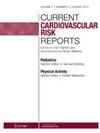人工智能在冠心病一级预防风险评估中的应用
IF 1.8
Q3 CARDIAC & CARDIOVASCULAR SYSTEMS
引用次数: 0
摘要
冠状动脉疾病(CAD)是世界范围内常见且病因复杂的疾病。目前的一级预防或预防首次急性事件指南包括相对简单的风险评估,并在风险确定和预防战略选择方面留下了很大的改进空间。在这里,我们回顾了大数据和预测建模的进步如何预示着CAD风险评估和精准医疗的美好未来。人工智能(AI)提高了高维数据的实用性,为更好地了解众多CAD风险因素之间的相互作用提供了机会。除了人工智能在心脏成像中的应用,人工智能在医疗保健中的先锋应用,最近的转化研究也揭示了人工智能在使用标准生物标志物、遗传和其他组学技术、各种生物传感器和来自电子健康记录(EHRs)的非结构化数据进行多模式风险预测方面的有前途的途径。然而,人工智能模型的临床验证仍然存在差距,最明显的是在复杂风险预测的可操作性方面,以进行更精确的治疗干预。最近全国性生物库数据集的可用性为利用在家庭、实验室和通过诊所就诊收集的健康数据丰富地描述纵向健康轨迹提供了巨大的机会。深度基因型-表型数据的日益可用性,将推动临床决策从简单的风险预测算法向复杂的、“数据饥渴”的人工智能模型过渡。虽然人工智能模型提供了将所有风险因素纳入综合风险预测框架的手段,但仍需要将这些预测包装在可解释的框架中,以映射我们对潜在生物机制和相关个性化干预的理解。这篇综述探讨了机器学习和人工智能在CAD一级预防中的作用的最新进展,并强调了当前的优势以及潜在未来应用的局限性。本文章由计算机程序翻译,如有差异,请以英文原文为准。
Artificial Intelligence for Risk Assessment on Primary Prevention of Coronary Artery Disease
Abstract Purpose of Review Coronary artery disease (CAD) is a common and etiologically complex disease worldwide. Current guidelines for primary prevention, or the prevention of a first acute event, include relatively simple risk assessment and leave substantial room for improvement both for risk ascertainment and selection of prevention strategies. Here, we review how advances in big data and predictive modeling foreshadow a promising future of improved risk assessment and precision medicine for CAD. Recent Findings Artificial intelligence (AI) has improved the utility of high dimensional data, providing an opportunity to better understand the interplay between numerous CAD risk factors. Beyond applications of AI in cardiac imaging, the vanguard application of AI in healthcare, recent translational research is also revealing a promising path for AI in multi-modal risk prediction using standard biomarkers, genetic and other omics technologies, a variety of biosensors, and unstructured data from electronic health records (EHRs). However, gaps remain in clinical validation of AI models, most notably in the actionability of complex risk prediction for more precise therapeutic interventions. Summary The recent availability of nation-scale biobank datasets has provided a tremendous opportunity to richly characterize longitudinal health trajectories using health data collected at home, at laboratories, and through clinic visits. The ever-growing availability of deep genotype-phenotype data is poised to drive a transition from simple risk prediction algorithms to complex, “data-hungry,” AI models in clinical decision-making. While AI models provide the means to incorporate essentially all risk factors into comprehensive risk prediction frameworks, there remains a need to wrap these predictions in interpretable frameworks that map to our understanding of underlying biological mechanisms and associated personalized intervention. This review explores recent advances in the role of machine learning and AI in CAD primary prevention and highlights current strengths as well as limitations mediating potential future applications.
求助全文
通过发布文献求助,成功后即可免费获取论文全文。
去求助
来源期刊

Current Cardiovascular Risk Reports
CARDIAC & CARDIOVASCULAR SYSTEMS-
CiteScore
3.00
自引率
0.00%
发文量
23
期刊介绍:
The aim of this journal is to keep readers informed by providing cutting-edge reviews on key topics pertaining to cardiovascular risk. We use a systematic approach: international experts prepare timely articles on relevant topics that highlight the most important recent original publications. We accomplish this aim by appointing Section Editors in major subject areas across the discipline of cardiovascular medicine to select topics for review articles by leading experts who emphasize recent developments and highlight important papers published in the past year. An Editorial Board of internationally diverse members suggests topics of special interest to their country/region and ensures that topics are current and include emerging research. We also provide commentaries from well-known figures in the field.
 求助内容:
求助内容: 应助结果提醒方式:
应助结果提醒方式:


